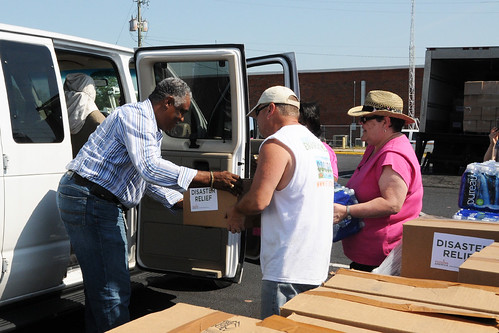
September is National Preparedness Month, a time to evaluate the many ways that we can prepare our families and communities before, during, and after a disaster or emergency. Whether they come in the form of a hurricane, earthquake or drought, being prepared is the best defense against long-term, negative impacts. One of the ways USDA supports disaster victims is by supplying food for The Emergency Food Assistance Program (TEFAP). These purchases not only help those unfortunate enough to be affected by the disaster, they also put to use the abundance of foods produced by American farmers and processors.
Through our Commodity Procurement Program, USDA’s Agricultural Marketing Service (AMS) makes purchases for household federal food programs like TEFAP. Some of the food that supplies this program, which is administered by USDA’s Food and Nutrition Service (FNS), comes from the AMS bonus buy program.
Bonus buys – including those recently approved for canned salmon, bottled grape juice, and frozen chicken – help protect American farmers from unexpected market conditions that affect their businesses by providing an outlet for surplus goods. The purchases eventually reach households all over the country as the food is distributed through food banks and other charitable institutions.
In addition to helping American farmers, AMS purchases supply quality, domestically produced food to families in need. Often, food banks and charitable organizations request canned foods because they are shelf-stable and easy to prepare. In their role as first responders, food banks working with FNS to supply food to victims of disasters often choose canned food for this same reason.
There are many ways that USDA Foods play an important role in supporting disaster response efforts. The existing inventory – much of which is canned, bottled, or other types of shelf-stable products at local food banks – can be tapped into immediately to help disaster victims. AMS and FNS also work to replenish the inventory afterwards.
During Hurricane Sandy, USDA used the Web-Based Supply Chain Management System (WBSCM) to re-route the paths of delivery trucks, directing them to the areas most affected by the storm. As a result, USDA Foods helped feed Hurricane Sandy victims at a time when they needed it most.
We work with organizations like the Midwest Food Processors Association (MWFPA) and the Can Manufacturers Institute to make sure that canned foods delivered to TEFAP and other federal food purchase programs are quality, healthy items. For example, our USDA canned vegetables are either low-sodium or have no salt added, while the canned fruits are packed in extra-light syrup or sucrose.
USDA is committed to supporting local, state, and national disaster response efforts. If you are in need of food for your family in the midst of a disaster, contact your local Red Cross or another disaster organization.

